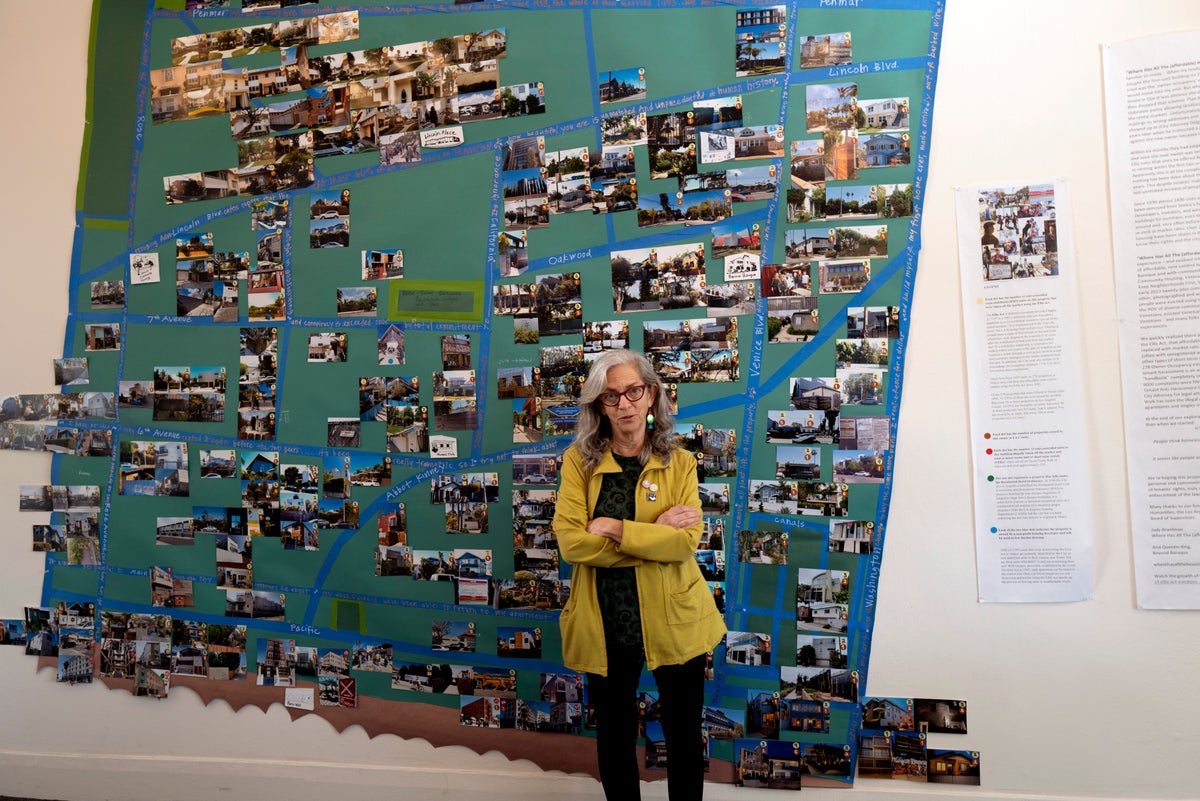
As more and more of her friends and neighbors found themselves priced out of rental units in Venice Beach, Judy Branfman began photographing the dozens of houses, bungalows and apartments being sold, renovated and then relisted at double or triple the cost.
Branfman started with only the vague idea that she should be documenting the growing problem of evictions and housing unaffordability in her beloved west Los Angeles neighborhood. The writer and activist lamented that Venice, where tourists flock to the famous boardwalk and Muscle Beach, has been slowly shedding its historically bohemian vibe and becoming another enclave for the wealthy.
Word spread about her photo project and earlier this year Branfman started hosting community meetings where residents could share their experiences with evictions that forced them to move out of the area and, in some cases, into homelessness. Some people recited poems. Others expressed themselves through paintings. And the more academically-minded among them began compiling housing and eviction statistics.
Branfman's initial notion to just shoot a few photos has culminated in an unlikely but ambitious art-meets-data exhibit titled “Where Has All The (affordable) Housing Gone?” It's on display through Saturday at Venice's venerable Beyond Baroque gallery, a hub for cultural events and activism dating back to the late 1960s.
“The idea was to illustrate the problem, to show what we've lost. You know, make it visual so people would walk in and be a little shocked, and want to do something about it,” Branfman said at the gallery this week.
Venice became a center of the Los Angeles homelessness crisis during the coronavirus pandemic, when camps sprouted up in residential neighborhoods and along the sands. The nation’s second-largest city also has 46,000 residents who are homeless among the overall population of 4 million people, according to the most recent survey.
The area was a flashpoint because of its visibility as a city landmark — the boardwalk attracts an estimated 10 million visitors per year. A certain edginess always coexisted with a live-and-let-live ethos in the artsy beach community, but the widening of the wealth gap has become increasingly apparent as tech firms moved in and sleek modern homes went up.
As building owners seek to bring in more deep-pocketed renters, longtime residents find themselves dealing with rent increases that overwhelm their finances. Some 80% of low-income Los Angeles renters pay over half their income toward housing costs, according to data released this week by the nonprofit Angeleno Project.
While Los Angeles is on track to meet certain goals for new housing set out by recent ballot measures, “supply is severely behind demand,” the report found.
“Some 3,500 housing units are at high or very high risk of losing their affordability terms, threatening to push more families into homelessness,” said the report. “A significant dip in affordable housing that started in 2022 post-COVID-19 continues to trend downward.”
Upon entering Branfman's exhibit, visitors are confronted by her photos on an enormous and detailed map depicting, block by block, many of the nearly 1,500 rent-controlled units she says have disappeared from the housing market in Venice over two decades. In many instances, the buildings were sold to large corporations that are increasingly buying up properties and jacking up rents.
The map, and much of the exhibit, pins some of the blame for the problem on the Ellis Act, a 1985 California law that gave landlords broad authority to evict tenants in rent-controlled buildings for redevelopment, and then later list the same units at market rates. Branfman said she was “Ellis Acted” when she was evicted from a Venice apartment in 2003.
“Too many tenants are afraid to fight back. And most don't know what their rights are under the law,” she said. And even when tenants do file complaints against landlords, she said, the city very rarely prosecutes the claims.
On the wall opposite the map is a free-verse poem made up of quotes about why many renters are were afraid to take on landlords, such as: “I don't want any trouble" and "My neighbors aren't documented and they're afraid if they say anything they'll be targeted."
Upstairs there are paintings and mixed-media figurines that the artist Sumaya Evans calls “dignity dolls.” Evans, who was homeless in Venice for years before recently finding housing, said creating art gave her a sense of self-worth when she was living on the streets.
“You get used to being ignored as a homeless woman. People are blind to you when you're outside,” she said. “And so being a part of of a project like this, being a part of a community, is just so healing.”
Branfman and other housing activists are hopeful that change could come with measure that's qualified for the 2024 ballot. The initiative that will go before voters would expand local control by overturning a 28-year-old law that prohibits rent control on single-family homes, condos and rental units that were built after 1995.
After the exhibit closes Saturday, Branfman hopes to find a home for some of the installations at a library or university. Most of it will live virtually on its own Instagram page.
“The rest of it will be on display in my apartment,” she laughs.







